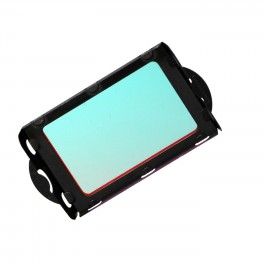 Ingrandisci
Ingrandisci Astronomik OWB Typ 3 Clip-Filter EOS XL
Astronomik
- Rimuovi questo prodotto dai miei preferiti
- Aggiungi questo prodotto ai miei preferiti.
- Stampa
Astronomik OWB - Terrestrial Clip Filter for Canon EOS full-size sensor cameras
 Ingrandisci
Ingrandisci Astronomik OWB - Terrestrial Clip Filter for Canon EOS full-size sensor cameras
Codice articolo: 8h00j1
![Astronomik OWB - Terrestrial Clip Filter for Canon EOS full-size sensor cameras [EN] Astronomik OWB - Terrestrial Clip Filter for Canon EOS full-size sensor cameras [EN]](https://www.teleskop-express.it/img/cms/astronomik-owb%20eos%20xl.jpg)
The OWB filter would usually not be designated as an "astronomical" filter. The intention is to enable converted DSLR cameras (without inbuilt IR-filter) in order to be used for ´terrestrial´ photography.
The OWB (Original White Balance) filter shifts the complete spectrum of a converted DSLR in such a manner that the camera will not be exclusively usable for astro-photography. Therefore the decision, which in former times had to be made, whether to ´victimize´ a DSLR in order to exclusively use it for astronomical tasks or accept the lower sensitivity on the red end of the spectrum, it is now a thing of the past and disencumber your purse, too.
Note: the optical viewfinder does not work with installed EOS XL Clip-Filter, as the flip-mirror is fixed in the upper position!
Compatibility:
Canon EOS 5D and 6D with full-size sensor
Main use:
DSLR cameras which have been converted for astronomical use by removing the inbuilt IR-filter or by substituting it with a filter with greater range for H-alpha, have a white balance that made them unable for ´terrestrial´ purpose. The spectral sensitivity of the DSLR will be changed by an OWB-Filter to the former range. In other words: The OWB pretend to be the conventional built-in filter!
Use of the Filter:
Adapting modified DSLR cameras (removed or substituted inbuilt IR-filter) to achieve standard colour space in digital imaging via a special spectral curve.
Filter transmission curve:
![Astronomik OWB - Terrestrial Clip Filter for Canon EOS full-size sensor cameras [EN] Astronomik OWB - Terrestrial Clip Filter for Canon EOS full-size sensor cameras [EN]](https://www.teleskop-express.it/img/cms/astronomik-owbccd_1.jpg)
♦ The horizontal axis is the wavelength in nanometers (nm). 400 nm is deep blue, at 520 nm the human eye senses green and at 600 nm red. At 656 nm is the famous "H-Alpha" emission line of hydrogen.
♦ The transmission in % is plotted on the vertical axis.
♦ The red line shows the transmission of the filter.
♦ Visual filters: The grey line in the background shows the relative sensitivity of the human eye at night. The maximum is at ~510 nm and drops to longer and shorter wavelengths. You can easily see, that you can´t see anything of the H-alpha line at night (even if you can during daylight!) The sensitivity at 656 nm is 0% at night!
♦ Photographic filters: The grey line in the background shows the sensitivity of a typical CCD sensor.
♦ The most important artifical emission lines are shown in orange. The artifical light pollution is dominated by see mercury (Hg) and sodium (Na), which are used in nearly all streetlights.
♦ The most important emission lines from nebulas are shown in green. The most important lines are from ionized hydrogen (H-alpha and H-beta), double ionized oyxgen ([O III]) and ionized sulfur ([S II]). The square brackets indicate that these lines are forbidden.
